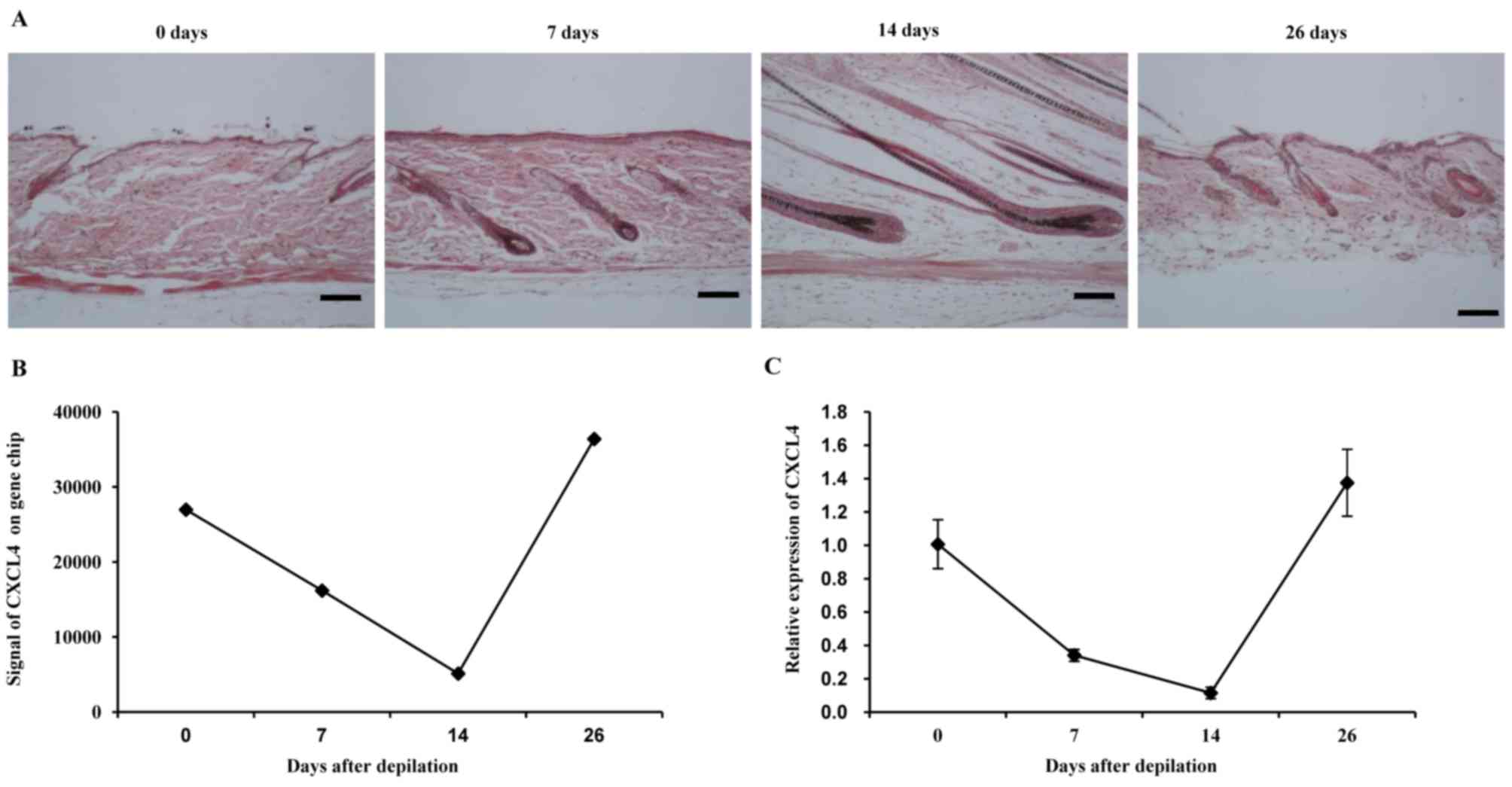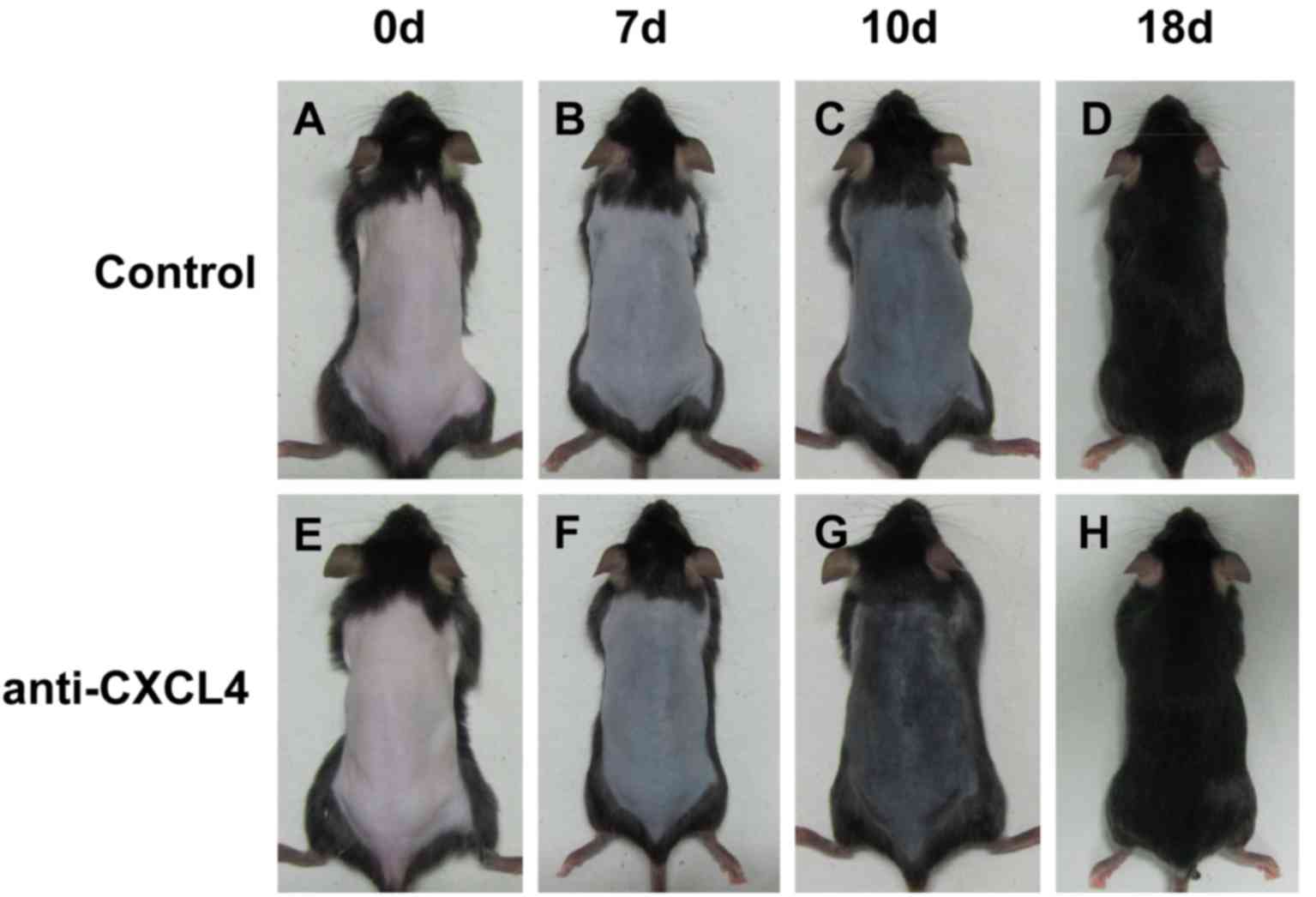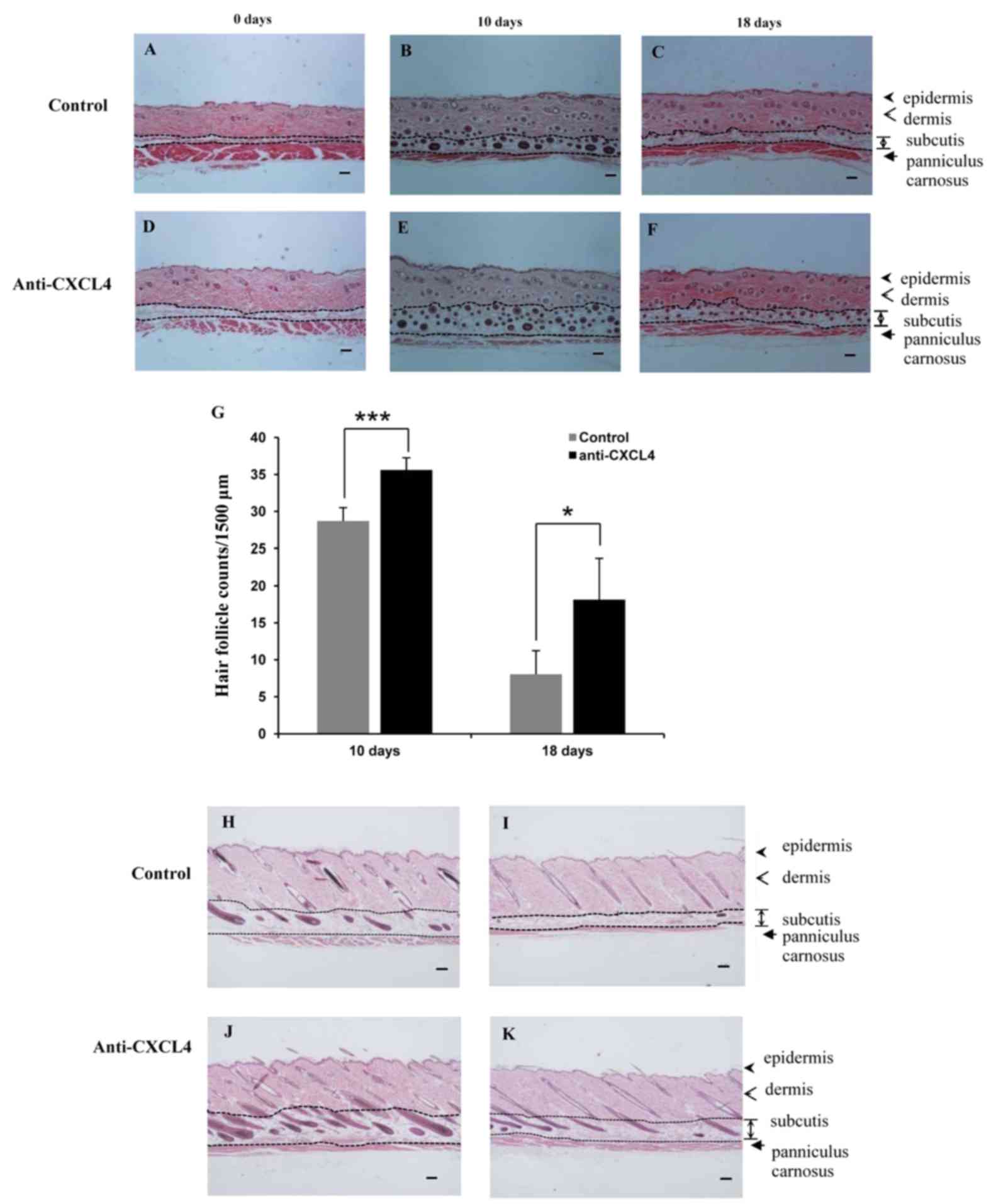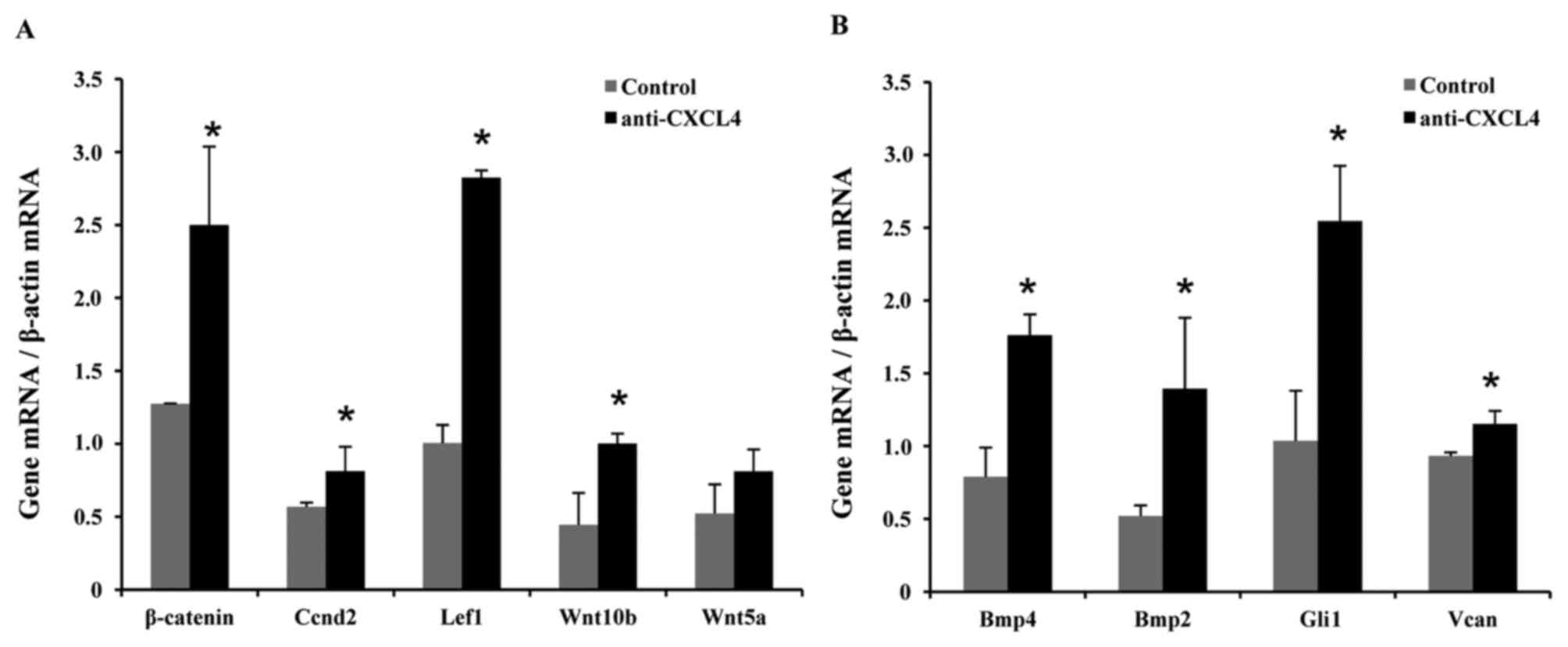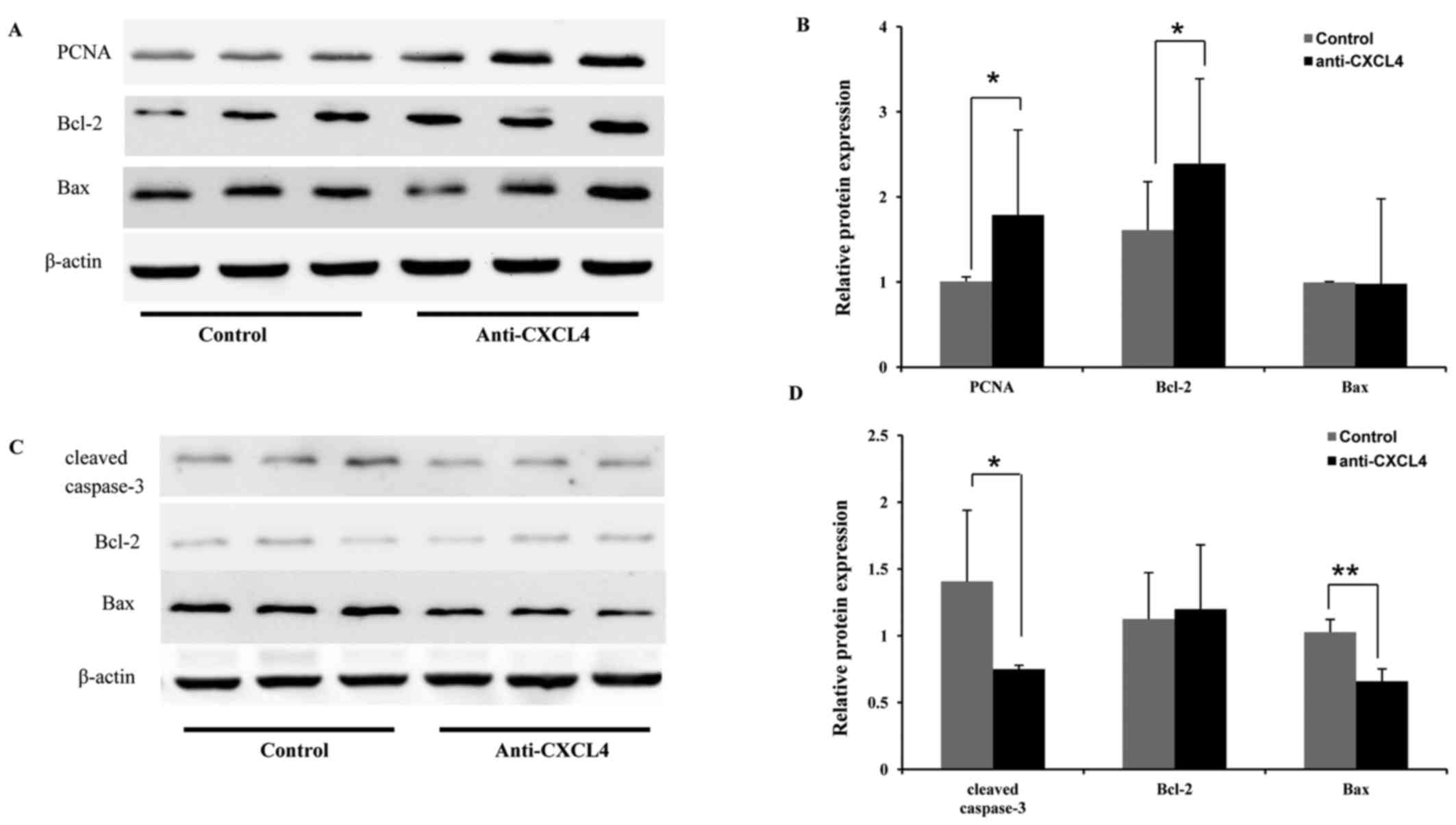Anti-CXCL4 monoclonal antibody accelerates telogen to anagen transition and attenuates apoptosis of the hair follicle in mice
- Authors:
- Published online on: June 12, 2017 https://doi.org/10.3892/etm.2017.4578
- Pages: 1001-1008
-
Copyright: © Guan et al. This is an open access article distributed under the terms of Creative Commons Attribution License.
Abstract
Introduction
Hair is considered to be an accessory structure of the integumentary system, along with sebaceous glands, sweat glands and nails. Hair growth is cyclic, involving a growth (anagen) phase, an apoptosis-mediated regression (catagen) phase and a resting (telogen) phase (1,2). Hair loss or alopecia is becoming more prevalent worldwide (3). Although hair loss is generally not life-threatening, it has been shown to have a substantial negative impact on social interactions and psychological well-being (4). To date, most marketed anti-hair-loss products are ineffective. Finasteride and minoxidil are the only two products approved for hair loss by the US Food and Drug Administration. However, their use is limited owing to unpredictable efficacy and undesirable side effects (5). Therefore, it is urgently necessary to develop novel pharmacological treatments.
Various cytokines and growth factors contribute to the regulation of hair morphogenesis and the hair growth cycle. Chemokine (C-X-C motif) ligand 4 (CXCL4; also known as platelet factor-4) is a member of the CXC chemokine family of small (8–10 kDa) proteins (6). CXCL4 was first described by Deutsch et al in 1955 and was demonstrated to be a platelet protein with anti-heparin activity (7). CXCL4 is a 7.8-kDa protein comprising 70 amino acids, that is synthesized in megakaryocytes, expressed in other cells, and stored in α-granules (8). CXCL4 has been reported to have numerous biological effects, including immunization, apoptosis, cell differentiation, survival, proliferation and tissue repair effects (9). CXCL4 inhibits the spontaneous apoptosis of monocytes and mediates their differentiation into a specific subtype of macrophages (9,10). It also promotes the survival of hematopoietic stem cells and progenitor cells (11). Moreover, CXCL4 has been reported to have an antiproliferative effect on endothelial cells and fibroblasts, in addition to anti-angiogenic activity (12–15). In addition, CXCL4 participates in mediation of the cell recruitment and activation necessary for inflammation and the repair of tissue damage (6). However, to the best of our knowledge, the role of CXCL4 in the hair growth cycle has not yet been reported.
Hair shafts are made by the hair follicle, which undergoes self-renewal when hairs are damaged. The present study is based on the proposal that homeostatically regulated gene expression during the hair cycle is essential for hair growth. In order to identify those genes, a genome-wide gene expression array using a depilation-induced hair growth mouse model was performed.
The aim of the present study was to determine whether CXCL4 is an important gene in hair regeneration. Previously, the present authors identified that CXCL4 induced apoptosis of the IEC-6 intestinal epithelial cell line, and that CXCL4 monoclonal antibody (mAb) reduced the apoptosis of the crypt epithelia in a 5-fluorouracil-induced mucositis model (16). Therefore, it was hypothesized that CXCL4 may retard hair growth by exerting an anti-proliferative effect on hair follicle cells, whereas CXCL4 mAb may promote hair growth by stimulating follicular proliferation and delaying the catagen phase. The present study demonstrated that the expression of CXCL4 was downregulated following the transition from the telogen to the anagen phase, and returned to the normal level following the next telogen phase. CXCL4 mAb significantly promoted the initiation of the hair follicle transition from the telogen to the anagen phase through upregulation of hair growth-related genes in vivo. These results indicated that CXCL4 plays an important role in hair growth.
Materials and methods
Reagents
Antibodies against Bcl-2 (3498), Bax (2772) and the cleaved form of caspase-3 (9664) were purchased from Cell Signaling Technology, Inc. (Danvers, MA, USA). Antibodies against proliferating cell nuclear antigen (PCNA) (sc-25280) and β-actin (sc-47778) were from Santa Cruz Biotechnology, Inc. (Dallas, TX, USA). Rat immunoglobulin G (IgG) was purchased from Sigma-Aldrich (Merck KGaA, Darmstadt, Germany). CXCL4 mAb was produced in the laboratory, as previously described (16).
Experimental animals
All experiments with mice were conducted in accordance with the Guide for the Care and Use of Laboratory Animals (National Academies Press, Washington, DC, USA, 1996) and were approved by the Animal Research Committee of Shanghai Jiaotong University (Shanghai, China). Male C57BL/6 mice were purchased from Shanghai SLAC Laboratory Animal Co., Ltd. (Shanghai, China). The 6-week-old mice (17–20 g) were allowed to adapt to their new environment for 1 week. Mice were housed in standard animal rooms with food and water available ad libitum under controlled humidity (50±15%) and temperature (22±2°C). The room was illuminated by fluorescent lights that were on from 8:00 a.m. to 8:00 p.m.
Microarray analysis
Microarray analysis was conducted by Shanghai Biotechnology Corporation (Shanghai, China). Total RNA was extracted using TRIzol reagent (Thermo Fisher Scientific, Inc., Waltham, MA, USA) from excised C57BL/6 mouse back skin, followed by purification, using RNeasy Mini kit (Qiagen GmBH, Hilden, Germany) and RNase-Free DNase set (Qiagen GmBH). Total RNA was amplified and labeled using a Low Input Quick Amp Labeling kit, One-Color (Agilent Technologies, Inc., Santa Clara, CA, USA). Labeled cRNA was hybridized with Mouse Genome Microarray 4*44K (Agilent Technologies, Inc.) and washed according to the manufacturer's recommendations. Slides were scanned using an Agilent Microarray Scanner (G2565CA; Agilent Technologies, Inc.). The signals were analyzed using Feature Extraction Software 10.7 (Agilent Technologies, Inc.), excluding the data from signals that were recognized as outlier or equal to background. Raw data were normalized by Quantile algorithm, Gene Spring Software 11.0 (Agilent Technologies, Inc.).
Experimental analysis using CXCL4 mAb
Twenty C57BL/6 mice in two randomized groups (n=10) were used for studying the activity of CXCL4 mAb. The anagen phase was induced by depilation on the dorsal skin of the animals at 7 weeks old. This was performed by applying a melted wax/rosin mixture to the dorsal skin and peeling off this mixture after hardening, as previously described (17). All depilated mouse hair follicles were synchronized in the telogen stage. The animals in the test group were subcutaneously injected with CXCL4 mAb (1 mg/kg body weight) once a week for three consecutive weeks, and the control group were subcutaneously injected with rat isotype IgG (1 mg/kg body weight) once a week for three consecutive weeks. The dorsal skin of the mice was observed and photographic images were captured on 0, 7, 10 and 18 days after depilation. Three mice from each time point were sacrificed to obtain skin specimens. Briefly, after being euthanized, mice were shaved with mechanical clippers and total, fully-thickness dorsal skin was dissected free. The skin was frozen quickly in liquid nitrogen prior to analysis.
Histological preparation
Dorsal skin of the mice was fixed with 10% neutral buffered formalin. The tissues were dehydrated through an ascending series of graded ethanol, cleared in xylene, and embedded in paraffin blocks. Subsequently, samples were cut either longitudinally or transversely into 5-µm sections. These sections were stained with hematoxylin and eosin (H&E), and the histological morphology was examined using light microscopy.
Hair follicle counting
Digital photomicrographs were taken from representative areas of slides at a fixed magnification of ×40. All images were cropped in a fixed area with a width of 1,500 µm. The hair follicles in the deep subcutis were counted manually, as previously described (5).
Reverse transcription-quantitative polymerase chain reaction (RT-qPCR)
Total RNA was extracted from the skin using two-step RNA extraction with TRIzol (Invitrogen; Thermo Fisher Scientific, Inc.). Reverse transcription (RT) reaction was performed with RNA (2 µg) at 37°C for 15 min and 85°C for 5 sec according to the PrimeScript RT reagent kit (Takara Biotechnology Co., Ltd., Dalian, China). The product was amplified in a reaction volume of 20 µl containing 9.2 µl RT product, 10 µl SYBR Premix Ex Taq II (2x) (Takara Biotechnology Co., Ltd.), and 20 pmol of each primer. PCRs were performed for 40 cycles at 95°C for 10 sec, 60°C for 30 sec and 72°C for 30 sec using a 7900HT Fast Real Time RT-PCR System (Applied Biosystems; Thermo Fisher Scientific, Inc.). Three replicates were performed at each time point. All data were normalized to β-actin mRNA levels, and the fold change for each mRNA was calculated using the 2−∆∆Cq method (18). The primer sequences used are shown in Table I.
Table I.Sequences of forward and reverse primers for reverse transcription-quantitative polymerase chain reaction. |
Western blot analysis
Skin tissue (100 mg) was homogenized in 1 ml radioimmunoprecipitation assay lysis buffer with protease and phosphatase inhibitors (Beyotime Institute of Biotechnology, Haimen, China). Supernatants were recovered after 12,000 × g centrifugation at 4°C for 10 min, and their protein content was determined using a bicinchoninic acid assay kit (P001; Beyotime Institute of Biotechnology). Proteins (30 µg) were separated using 12% SDS-PAGE gels, and transferred to a polyvinylidene difluoride membrane. Membranes were blocked in 5% non-fat dry milk for 2 h at room temperature and incubated with anti-PCNA (1:1,000 dilution, sc-25280, Santa Cruz Biotechnology, Inc.), anti-cleaved caspase-3 (1:1,000 dilution, 9664, Cell Signaling Technology, Inc.), anti-Bcl2 (1:1,000 dilution, 3498, Cell Signaling Technology, Inc.), anti-Bax (1:1,000 dilution, 2772, Cell Signaling Technology, Inc.), and anti-β-actin (1:1,000 dilution, sc-47778, Santa Cruz Biotechnology, Inc.) primary antibodies overnight at 4°C and then with the corresponding HRP-conjugated secondary antibodies (1:5,000, 7044 and 7066, Cell Signaling Technology, Inc.) for 2 h at room temperature. The membranes were washed and visualized using enhanced chemiluminescence reagents (Thermo Fisher Scientific, Inc.) and analyzed using a gel imaging system (Tanon 3500; Tanon Science and Technology Co., Ltd., Shanghai, China). β-actin was employed as a loading control. Three replicates were performed for each treatment.
Statistical analysis
All data are presented as the mean ± standard deviation from three independent experiments. All statistical analysis was performed using SPSS 18.0 (SPSS, Inc., Chicago, IL, USA). Differences between experimental groups were evaluated by Student's t-test. P<0.05 was considered to indicate a statistically significant difference.
Results
Expression of CXCL4 during the induced mouse hair cycle
In the mouse model used in the present study, a new cycle of hair growth was induced by depilation, as previously described (17). The anagen phase was fully synchronized over the entire area of depilation. At 0 and 26 days, typical telogen morphology, including the entire hair follicle residing in the dermis and lacking melanin, was observed in the hair matrix above the dermal papilla. At 7 and 14 days, enlarged dermal papillae were observed. In addition, elongated hair shafts emerged (Fig. 1A). Gene expression of the total dorsal skin taken from mice at several time points following depilation (7, 14 and 26 days) was analyzed by DNA microarray hybridization and compared with skin samples taken at the telogen phase (0 days). The expression of CXCL4 was identified to be decreased during the anagen phase (0–14 days) and returned to the normal level during the telogen phase (26 days; Fig. 1B). The homeostatic regulation of CXCL4 shown in the expression array was confirmed by RT-qPCR (Fig. 1C). The expression pattern of CXCL4 in the hair cycle suggests its participation in hair growth following depilation.
CXCL4 mAb promotes hair regeneration
The homeostatic regulation of CXCL4 in the skin strongly suggests its role in hair growth. A strategy of using a neutralizing mAb to block CXCL4 was used to evaluate the role of CXCL4 in hair growth. Adult C57BL/6 mice are useful for testing hair growth-promoting reagents, as their truncal pigmentation is dependent on their follicle melanocytes, which produce pigment only during anagen (19). It has been reported that the skin color of mice is pink in the telogen phase, and gradually becomes grey and black along with anagen initiation (20). Thus, black pigmentation is taken as evidence of the transition of hair follicles from the telogen to the anagen phase.
To evaluate the hair growth activity of CXCL4 mAb, the depilated mice were treated with CXCL4 mAb once a week, for 3 weeks. Each day, the degree of hair growth was evaluated by observing the skin color. Darker skin was observed in the CXCL4 mAb-treated group at 7 and 10 days, compared with that of the control mice treated with isotype IgG (Fig. 2). These results indicate that CXCL4 mAb significantly stimulated hair growth.
Effects of CXCL4 mAb on the development and structure of mouse hair follicles
An increase in the number of hair follicles has been considered as an indicator of the transition of hair growth from the telogen to the anagen phase. The anagen phase is associated with an increase in the number of hair follicles that lie in the deep subcutis compared with that of the telogen phase, in which hair follicles lie in the dermis only (20). The effect of CXCL4 mAb on hair follicle density was further assessed via histological analysis of mouse skin samples following staining with H&E (Fig. 3A-F). CXCL4 mAb significantly increased the number of hair follicles in mice, compared with that in the control group at 10 and 18 days (P<0.05; Fig. 3G).
In accordance with the classification of hair cycle stages in mice (1), hair follicles at 18 days following depilation are in the catagen phase. Longitudinal sections of dorsal skins are shown in Fig. 3H-K. It was observed that regression of the hair follicles pulled the dermal papillae upward into the dermis in the control group (Fig. 3I). By contrast, almost all of the hair follicles in the CXCL4 mAb-treated group continued to reside in the subcutis (Fig. 3K). These observations indicate that blockade of CXCL4 induced an earlier anagen phase and prolonged the mature anagen phase, compared with that in the control group.
CXCL4 mAb upregulates Wnt- and bone morphogenetic protein (Bmp)-dependent signaling
Previous studies demonstrated that transient activation of Wnt-dependent β-catenin signaling in cutaneous keratinocytes is sufficient to trigger the active growth phase of the hair cycle in mice (21,22). Therefore, total RNA was isolated from C57BL/6 skin samples at 10 days after depilation and expression levels of Wnt pathway genes were examined using RT-qPCR. Increased mRNA levels of β-catenin (2.0-fold), cyclin D2 (Ccnd2; 1.4-fold), lymphoid enhancer binding factor 1 (Lef1; 2.8-fold), Wnt10b (2.3-fold) and Wnt5a (1.5-fold) were observed in the mice treated with CXCL4 mAb compared with the control mice (Fig. 4A).
Previous studies have revealed that the Bmp pathway may provide a molecular target for anagen induction and hair growth in mice and humans (23), and that Wnt1a-conditioned medium upregulates hair-induction related genes (24). Similar to the aforementioned RT-qPCR experiments, increased mRNA levels of Bmp4 (2.2-fold), Bmp2 (2.7-fold), GLI-Kruppel family member GLI1 (Gli1; 2.5-fold) and versican (Vcan; 1.2-fold) were found in the mice treated with CXCL4 mAb in comparison with the control mice (Fig. 4B).
Effects of CXCL4 mAb on proliferation- and apoptosis-associated proteins
Whole-tissue lysates of dorsal skin tissues were utilized to investigate the effects of CXCL4 mAb on proliferation- and apoptosis-associated factors in hair growth and regression. At 10 days, CXCL4 mAb was observed to significantly increase Bcl-2 (1.5-fold) and PCNA (1.8-fold) expression during the anagen phase, compared with that in the control group (Fig. 5A and B). In addition, at 18 days, CXCL4 mAb treatment significantly reduced the protein expression of two apoptosis-associated factors, Bax (1.6-fold) and cleaved caspase-3 (1.9-fold), compared with that in the control group, indicating that CXCL4 mAb prevented hair follicles from undergoing apoptosis (Fig. 5C and D). These results indicate that CXCL4 mAb promoted hair regrowth and delayed hair regression.
Discussion
In the present study, a novel role for CXCL4 mAb in the promotion of hair growth in mice following depilation was uncovered. To the best of our knowledge, the present study is the first to report an association between CXCL4 and hair growth. It demonstrated that dorsal skin expressed low basal level of CXCL4 mRNA during the anagen phase of hair growth, and the expression level returned to normal following the next telogen phase. Furthermore, the present study demonstrated that CXCL4 was involved in the control of hair growth, and that neutralization of CXCL4 using a mAb significantly promoted hair growth in a depilated mouse model.
Previous studies have shown that CXCL4 inhibits endothelial cell proliferation and interferes with the cell cycle (12,25). It has been reported that CXCL4-stimulated human monocytes induce the apoptosis of endothelial cells via the release of oxygen radicals (26). This is consistent with our previous study, in which recombinant human CXCL4 was observed to induce the apoptosis of intestinal epithelial cells, CXCL4 mAb was demonstrated to protect mouse intestine from chemotoxicity (16). To the best of our knowledge, there are no previous reports concerning the effect of CXCL4 or anti-CXCL4 antibody on hair growth. In the present study, it was identified that the expression of CXCL4 was downregulated during the anagen phase and returned to the basal level at the telogen phase. The effect of CXCL4 mAb on hair growth was also investigated in the present study. The results suggest that CXCL4 mAb induces hair growth by promoting telogen to anagen transition of hair follicles, and suppresses apoptosis of hair follicles during the catagen phase in mice.
Hair cycling between the telogen and anagen phases is precisely regulated by dermal papilla (DP) cells. The Wnt pathway is an important signaling pathway that activates the hair induction ability of DP cells (27). β-catenin and Wnt5a expression are moderate in the early anagen phase, high in the middle anagen phase, and weak in the catagen and telogen phases (21,28). Adenovirus-mediated ectopic expression of Wnt10b was able to activate precocious anagen entry in a previous mouse model (29). Lef1 is an essential regulatory protein in the Wnt-signaling pathway that controls cell growth and differentiation (30). In the stem cell niche, Wnt signaling and β-catenin stabilization are considered to activate the Lef1/T-cell factor complex, which binds to its target genes and promotes stem cell activation and proliferation; these constitute critical steps required to support hair growth (31). Moreover, the Bmp signal transduction pathway also plays an important role in anagen induction (23). In the present study, elevated mRNA levels of Wnt-β-catenin signaling molecules were detected, including β-catenin, Ccnd2, Lef1, Wnt10b and Wnt5a at 10 days after depilation in mice (Fig. 4A). Furthermore, increased levels of Bmp4, Bmp2, Gli1 and Vcan were also found in mice treated with CXCL4 mAb (Fig. 4B). These findings are consistent with previous studies in which the expression levels of hair induction-related genes were upregulated in hair regrowth (24,32). The data demonstrate that CXCL4 mAb activates the Wnt/β-catenin- and Bmp-signaling pathways to mediate hair regeneration.
CXCL4 has been demonstrated to induce apoptosis of epithelia through activation of extrinsic and intrinsic death pathways (16,26), which is regulated primarily by Bcl-2 family proteins. The Bcl-2 family of proteins are either anti-apoptotic or pro-apoptotic in nature, notably the anti-apoptotic Bcl-2 and pro-apoptotic Bax proteins. Bcl-2 is considered to protect cells from apoptosis, while Bcl-2 activity is determined by interaction with Bax (33). The present study demonstrated that CXCL4 mAb increased the expression of the anti-apoptotic Bcl-2, whereas there was no significant change in the expression level of Bax in the skin at 10 days after depilation, at the anagen phase of hair follicles. Notably, the level of PCNA expression was clearly increased (Fig. 5). These results indicate that CXCL4 mAb promotes telogen to anagen transition by the stimulation of proliferation and suppression of apoptosis of hair follicular cells.
During hair follicle growth and hair production, factors promoting proliferation, differentiation and survival predominate in activity. However, hair follicle regression in the catagen phase is characterized by the activation of a number of signaling pathways that induce the apoptosis of hair follicle cells (34). In addition, in the process of hair follicle regression, caspase activation is required to induce apoptosis (35). Caspase-3 is a key executor of the apoptosis signal (36). In the present study, during the catagen phase (at 18 days after depilation), it was demonstrated that pro-apoptotic Bax expression was decreased, the expression of Bcl-2 was unchanged, and the expression of cleaved caspase-3 was significantly decreased in the skin treated with CXCL4 mAb (Fig. 5). During the catagen phase, the dermal papilla transforms into a cluster of quiescent cells near to the regressing hair follicle epithelium, which moves from the subcutis to the border of the dermis and subcutis (35). In the present study, suppression of hair follicle apoptosis prevented the dermal papilla from being pulled upwards from the subcutis to the dermis in the catagen phase of hair follicles in the mice treated with CXCL4 mAb (Fig. 3). Thus, CXCL4 mAb attenuated the apoptosis of hair follicle cells in the catagen phase and delayed hair follicle regression.
In conclusion, blockade of CXCL4 using CXCL4 mAb accelerated hair growth through promotion of telogen to anagen transition, and delayed the regression of hair follicles in the catagen phase. In-depth studies are necessary to further elucidate the molecular mechanisms through which CXCL4 mAb imparts its hair growth activity.
Acknowledgements
The present study was supported by the National Natural Science Foundation of China (No. 81273573) and the Science and Technology Commission of Shanghai Municipality (No. 11431921300).
References
|
Müller-Röver S, Handjiski B, van der Veen C, Eichmüller S, Foitzik K, McKay IA, Stenn KS and Paus R: A comprehensive guide for the accurate classification of murine hair follicles in distinct hair cycle stages. J Invest Dermatol. 117:3–15. 2001. View Article : Google Scholar : PubMed/NCBI | |
|
Schneider MR, Schmidt-Ullrich R and Paus R: The hair follicle as a dynamic miniorgan. Curr Biol. 19:R132–R142. 2009. View Article : Google Scholar : PubMed/NCBI | |
|
Wang TL, Zhou C, Shen YW, Wang XY, Ding XL, Tian S, Liu Y, Peng GH, Xue SQ, Zhou JE, et al: Prevalence of androgenetic alopecia in China: A community-based study in six cities. Br J Dermatol. 162:843–847. 2010. View Article : Google Scholar : PubMed/NCBI | |
|
Cotsarelis G and Millar SE: Towards a molecular understanding of hair loss and its treatment. Trends Mol Med. 7:293–301. 2001. View Article : Google Scholar : PubMed/NCBI | |
|
Zhang NN, Park DK and Park HJ: Hair growth-promoting activity of hot water extract of Thuja orientalis. BMC Complement Altern Med. 13:92013. View Article : Google Scholar : PubMed/NCBI | |
|
Miller MD and Krangel MS: Biology and biochemistry of the chemokines: A family of chemotactic and inflammatory cytokines. Crit Rev Immunol. 12:17–46. 1992.PubMed/NCBI | |
|
Deutsch E, Johnson SA and Seegers WH: Differentiation of certain platelet factors related to blood coagulation. Circ Res. 3:110–115. 1955. View Article : Google Scholar : PubMed/NCBI | |
|
Rendu F and Brohard-Bohn B: The platelet release reaction: Granules' constituents, secretion and functions. Platelets. 12:261–273. 2001. View Article : Google Scholar : PubMed/NCBI | |
|
Kasper B and Petersen F: Molecular pathways of platelet factor 4/CXCL4 signaling. Eur J Cell Biol. 90:521–526. 2011. View Article : Google Scholar : PubMed/NCBI | |
|
Scheuerer B, Ernst M, Dürrbaum-Landmann I, Fleischer J, Grage-Griebenow E, Brandt E, Flad HD and Petersen F: The CXC-chemokine platelet factor 4 promotes monocyte survival and induces monocyte differentiation into macrophages. Blood. 95:1158–1166. 2000.PubMed/NCBI | |
|
Han ZC, Lu M, Li J, Defard M, Boval B, Schlegel N and Caen JP: Platelet factor 4 and other CXC chemokines support the survival of normal hematopoietic cells and reduce the chemosensitivity of cells to cytotoxic agents. Blood. 89:2328–2335. 1997.PubMed/NCBI | |
|
Gupta SK and Singh JP: Inhibition of endothelial cell proliferation by platelet factor-4 involves a unique action on S phase progression. J Cell Biol. 127:1121–1127. 1994. View Article : Google Scholar : PubMed/NCBI | |
|
Luster AD, Greenberg SM and Leder P: The IP-10 chemokine binds to a specific cell surface heparan sulfate site shared with platelet factor 4 and inhibits endothelial cell proliferation. J Exp Med. 182:219–231. 1995. View Article : Google Scholar : PubMed/NCBI | |
|
Maione TE, Gray GS, Petro J, Hunt AJ, Donner AL, Bauer SI, Carson HF and Sharpe RJ: Inhibition of angiogenesis by recombinant human platelet factor-4 and related peptides. Science. 247:77–79. 1990. View Article : Google Scholar : PubMed/NCBI | |
|
Watson JB, Getzler SB and Mosher DF: Platelet factor 4 modulates the mitogenic activity of basic fibroblast growth factor. J Clin Invest. 94:261–268. 1994. View Article : Google Scholar : PubMed/NCBI | |
|
Gao J, Gao J, Qian L, Wang X, Wu M, Zhang Y, Ye H, Zhu S, Yu Y and Han W: Activation of p38-MAPK by CXCL4/CXCR3 axis contributes to p53-dependent intestinal apoptosis initiated by 5-fluorouracil. Cancer Biol Ther. 15:982–991. 2014. View Article : Google Scholar : PubMed/NCBI | |
|
Paus R, Stenn KS and Link RE: Telogen skin contains an inhibitor of hair growth. Br J Dermatol. 122:777–784. 1990. View Article : Google Scholar : PubMed/NCBI | |
|
Livak KJ and Schmittgen TD: Analysis of relative gene expression data using real-time quantitative PCR and the 2(−Delta Delta C(T)) Method. Methods. 25:402–408. 2001. View Article : Google Scholar : PubMed/NCBI | |
|
Plonka PM, Michalczyk D, Popik M, Handjiski B, Slominski A and Paus R: Splenic eumelanin differs from hair eumelanin in C57BL/6 mice. Acta Biochim Pol. 52:433–441. 2005.PubMed/NCBI | |
|
Datta K, Singh AT, Mukherjee A, Bhat B, Ramesh B and Burman AC: Eclipta alba extract with potential for hair growth promoting activity. J Ethnopharmacol. 124:450–456. 2009. View Article : Google Scholar : PubMed/NCBI | |
|
Huelsken J, Vogel R, Erdmann B, Cotsarelis G and Birchmeier W: beta-Catenin controls hair follicle morphogenesis and stem cell differentiation in the skin. Cell. 105:533–545. 2001. View Article : Google Scholar : PubMed/NCBI | |
|
Van Mater D, Kolligs FT, Dlugosz AA and Fearon ER: Transient activation of beta -catenin signaling in cutaneous keratinocytes is sufficient to trigger the active growth phase of the hair cycle in mice. Genes Dev. 17:1219–1224. 2003. View Article : Google Scholar : PubMed/NCBI | |
|
Mundy G, Gutierrez G, Garrett R, Gallwitz W, Rossini G, Christiansen C and Langenberg A: Proteasome inhibitors stimulate both bone formation and hair growth by similar mechanisms. Ann N Y Acad Sci. 1117:298–301. 2007. View Article : Google Scholar : PubMed/NCBI | |
|
Dong L, Hao H, Xia L, Liu J, Ti D, Tong C, Hou Q, Han Q, Zhao Y, Liu H, et al: Treatment of MSCs with Wnt1a-conditioned medium activates DP cells and promotes hair follicle regrowth. Sci Rep. 4:54322014. View Article : Google Scholar : PubMed/NCBI | |
|
Gentilini G, Kirschbaum NE, Augustine JA, Aster RH and Visentin GP: Inhibition of human umbilical vein endothelial cell proliferation by the CXC chemokine, platelet factor 4 (PF4), is associated with impaired downregulation of p21(Cip1/WAF1). Blood. 93:25–33. 1999.PubMed/NCBI | |
|
Woller G, Brandt E, Mittelstädt J, Rybakowski C and Petersen F: Platelet factor 4/CXCL4-stimulated human monocytes induce apoptosis in endothelial cells by the release of oxygen radicals. J Leukoc Biol. 83:936–945. 2008. View Article : Google Scholar : PubMed/NCBI | |
|
Soma T, Fujiwara S, Shirakata Y, Hashimoto K and Kishimoto J: Hair-inducing ability of human dermal papilla cells cultured under Wnt/β-catenin signalling activation. Exp Dermatol. 21:307–309. 2012. View Article : Google Scholar : PubMed/NCBI | |
|
Fuchs E and Raghavan S: Getting under the skin of epidermal morphogenesis. Nat Rev Genet. 3:199–209. 2002. View Article : Google Scholar : PubMed/NCBI | |
|
Li YH, Zhang K, Yang K, Ye JX, Xing YZ, Guo HY, Deng F, Lian XH and Yang T: Adenovirus-mediated Wnt10b overexpression induces hair follicle regeneration. J Invest Dermatol. 133:42–48. 2013. View Article : Google Scholar : PubMed/NCBI | |
|
Andl T, Reddy ST, Gaddapara T and Millar SE: WNT signals are required for the initiation of hair follicle development. Dev Cell. 2:643–653. 2002. View Article : Google Scholar : PubMed/NCBI | |
|
Gat U, DasGupta R, Degenstein L and Fuchs E: De Novo hair follicle morphogenesis and hair tumors in mice expressing a truncated beta-catenin in skin. Cell. 95:605–614. 1998. View Article : Google Scholar : PubMed/NCBI | |
|
Jiang S, Zhao L, Teklemariam T and Hantash BM: Small cutaneous wounds induce telogen to anagen transition of murine hair follicle stem cells. J Dermatol Sci. 60:143–150. 2010. View Article : Google Scholar : PubMed/NCBI | |
|
Adams JM and Cory S: The Bcl-2 protein family: Arbiters of cell survival. Science. 281:1322–1326. 1998. View Article : Google Scholar : PubMed/NCBI | |
|
Lindner G, Botchkarev VA, Botchkareva NV, Ling G, van der Veen C and Paus R: Analysis of apoptosis during hair follicle regression (catagen). Am J Pathol. 151:1601–1617. 1997.PubMed/NCBI | |
|
Botchkareva NV, Ahluwalia G and Shander D: Apoptosis in the hair follicle. J Invest Dermatol. 126:258–264. 2006. View Article : Google Scholar : PubMed/NCBI | |
|
Sabbagh L, Kaech SM, Bourbonnière M, Woo M, Cohen LY, Haddad EK, Labrecque N, Ahmed R and Sékaly RP: The selective increase in caspase-3 expression in effector but not memory T cells allows susceptibility to apoptosis. J Immunol. 173:5425–5433. 2004. View Article : Google Scholar : PubMed/NCBI |



